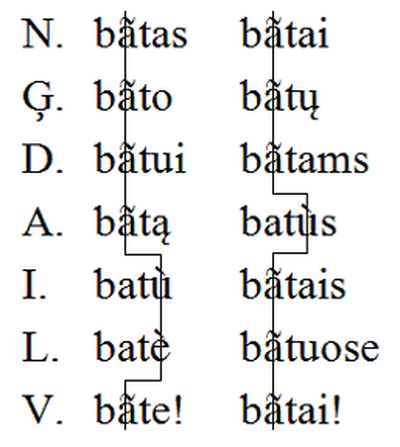Lithuanian varieties
Linguistic review
Lithuanian is a fusional language. It has:- two grammatical genders: masculine and feminine,
- singular and plural number ,
- 7 grammatical cases ,
- 5 declensions,
- 6 adjectival declensions (3 masculine and 3 feminine),
- adverbs,
- prepositions,
- pronouns (personal, possesive, indicative, interrogative, indefinite),
- numerals (cardinal , ordinal),
- 3 grammatical conjugations,
- 4 simple tenses (present, future, momentaneous past, multiple past) and 8 complex tenses (4 simultaneous and 4 perfect),
- moods: indicative, conditional, imperative, inferential,
- active, passive and reflexive voice,
- 13 active and passive participle forms (Vaičiulytė-Romančuk 2006
 Vaičiulytė-Romančuk 2006 / komentarz/comment/r /
Vaičiulytė-Romančuk 2006 / komentarz/comment/r /
Vaičiulytė-Romančuk, Ona 2006. Gramatyka języka litewskiego. Warszawa: Ex Libris. ).
).
- ~ circumflex – it means rising intonation,
- ՛ acute accent – it means falling intonation,
Moreover, there is also the
- ` grave accent – which means word stress.
 Vaičiulytė-Romančuk 2006 / komentarz/comment/r /
Vaičiulytė-Romančuk 2006 / komentarz/comment/r / Vaičiulytė-Romančuk, Ona 2006. Gramatyka języka litewskiego. Warszawa: Ex Libris.
 ).
).There are 4 accentual types of nouns, according to which the stress of the word is determined. Stress can change within one word depending on the grammatical case it is in.

Accentuation of a word ’batas’ (a shoe) and ‘batai’ (shoes), belonging to the second type. (Butkus 2011: 12
 Butkus 2011 / komentarz/comment/r /
Butkus 2011 / komentarz/comment/r / Butkus, Alvydas 2011. Lietuvių-latvių ir latvių-lietuvių kalbų žodynas. Kaunas: Aesti.
 )
)Lexical similarity is not limited to the similarities between Lithuanian and Latvian. A certain amount of Baltic vocabulary was borrowed by Finno-Ugric languages in time when peoples using those languages led a nomadic lifestyle -mostly words concerning the nomadic lifestyle, e.g. names of seeds (fiń. siemen, lit. sėmenys ‘seed’) (Zinkevičius 1996: 13
 Zinkevičius 1996 / komentarz/comment/r /
Zinkevičius 1996 / komentarz/comment/r / Zinkevičius, Zigmas 1996. The history of the Lithuanian language. Wilno: Mokslo ir enciklopedijų leidykla.
 ).
).Lithuanian was strongly influenced by Slavic languages (especially Polish and Belarussian). Slavic borrowings in the dialect of the Dzuks are phonetically more similar to Belarussian forms, for example: abrusas, Bel. abrus, Pol. obrus; bačka, Bel. bočka, Pol. bečka; ščupokas, Bel. ščupak, Pol. szczupak (Marcinkiewicz 2003: 104
 Marcinkiewicz 2003 / komentarz/comment/r /
Marcinkiewicz 2003 / komentarz/comment/r / Marcinkiewicz, Józef 2003. Polsko-litewskie kontakty językowe na Suwalszczyźnie. Poznań: Zakład Graficzny UAM.
 ).
).ISO Code
ISO 639-1 lt
ISO 639-2 lit
ISO 639-3 lit
The Linguasphere 54-AAA-a
ISO 639-2 lit
ISO 639-3 lit
The Linguasphere 54-AAA-a
- przyp01
- przyp02
- przyp03
- przyp04
- przyp05
- przyp06
- przyp07
- przyp08
- przyp09
- przyp10
- przyp11
- przyp12
- przyp13
- przyp14
- przyp15
- przyp16
- przyp17
- przyp18
- przyp19
- przyp20
- przyp21
- przyp22
- przyp23
- przyp24
- przyp25
- przyp26
- przyp27
- przyp28
- przyp29
- przyp30
- przyp31
- przyp32
- przyp33
- przyp34
- przyp35
- przyp36
- przyp37
- przyp38
- przyp39
- przyp40
- przyp41
- przyp42
- przyp43
- przyp44
- przyp45
- przyp46
- przyp47
- przyp48
- przyp49
- przyp50
- Hasiuk 1978
- Marcinkiewicz 2003
- Jackiewicz 2003
- Vaičiulytė-Romančuk 2006
- Niewulis 2005
- Zinkevičius 1978
- Tarnaiskaitė 2009
- Butkus 2011
- Jovaišas 1999
- Zinkevičius 1996
- Makowski 1986
- zagrożenie języków / language endangerment
- Godło Dzukiji
- Proste małe kanklės
- Kanklės z pulpitem
- Ludowy zespół muzyczny grający na gęślach
- Najstarszy litewski manuskrypt (pacierz) napisany
- Pierwsza strona Katechizmu Mażwida
- Ludy bałtyckie na przełomie XII i XIII w.
- Zasięg języka litewskiego w XVI wieku
- Litwa w latach 1867-1914, podział na gubernie
- Język litewski w II Rzeczypospolitej
- Gwary litewskie
- Etnograficzne regiony Litwy
- Dwujęzyczna tablica powitalna
- Gwary litewskie wg Zdancewicza
- Zbiór przedmiotów muzeum etnograficznego w Puńsku
- Przykłady strojów kobiecych
- Męski strój ludowy
- Piosenka ludowa w gwarze Dzuków 1
- Piosenka ludowa w gwarze Dzuków 2
- Akcentuacja wyrazów
- Tablica liceum w Puńsku
- Tablica szkoły podstawowej w Przystawańcach
- Podręczniki do szkoły podstawowej po litewski
- Tablica Domu Kultury w Puńsku
- Okładka dwutygodnika Aušra
- Okładka miesięcznika Aušrelė
- Publikacje o Litwinach w Polsce
- Publikacja o folklorze mniejszości litewskiej
- podręcznik do historii Litwy i regionu
- Podręcznik w języku litewskim